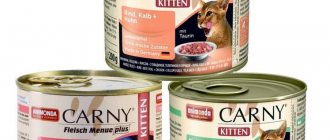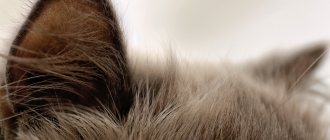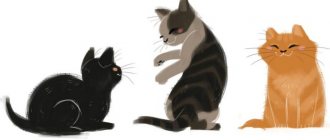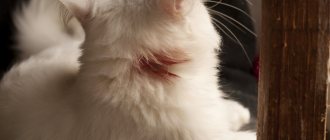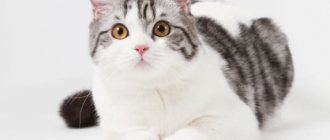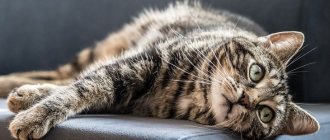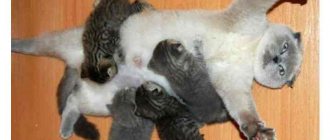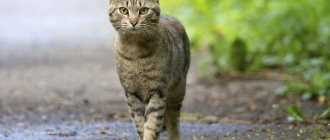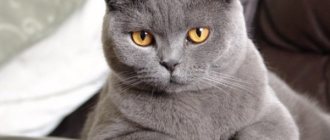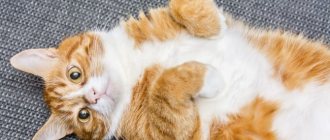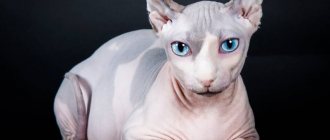Common diseases of Scottish Straight
The life of a Scottish can be marked by the following ailments:
- Frequent watery eyes. It’s worth noting right away that they can tear up even when their health is not in danger. It's all about the specific structure of the cat's skull, due to which the tear ducts are narrowed. You should be alert when your eyes run frequently, when purulent yellowish or reddish discharge appears. The first color indicates inflammatory processes, the second - the presence of worms. By the way, eyes can also leak when the animal’s immunity is low. However, the reasons may be trivial debris getting into the eye, scratches or allergies.
- Ear problems - despite the fact that this pet is straight-eared, sometimes they cannot be avoided. Problems can be recognized by the fact that the Scottish often shakes its ears, often scratches them, and reacts aggressively to the slightest touch to a sore spot. Discharge also appears. Of course, the issue may be the banal formation of sulfur in large quantities or injury during cleaning the sinks. However, the reason sometimes lies in otitis media, ear mites, and fungal infections.
- This breed also sometimes suffers from osteochondrodysplasia, although folds are more prone to it. However, it is important to be prepared for the fact that a similar genetic abnormality can affect straight-eared animals. In this case, cats begin to walk, limping on bent legs. Moreover, due to the deformation of the limbs, they not only have problems walking, but also have difficulty jumping on and off.
- Baldness – often a pregnant or lactating cat loses hair in large quantities. In most cases, veterinarians will explain this phenomenon by a lack of vitamins, which can easily be eliminated by prescribing special complexes or transferring the kitten to artificial feeding. However, pregnant individuals may suffer from toxicosis, scabies, dermatitis, allergies, and lichen.
- Urolithiasis - predominantly males, especially castrated ones, are prone to it. Overweight animals that consume low-quality ready-made food also suffer. The cause may be insufficient water saturation, lack of vitamin A, infection, hormonal imbalance and a banal dirty tray that the animal does not want to go into and tolerates. The disease manifests itself in a change in habitual behavior - for example, the Scottish pet often meows while urinating, may walk past the litter box, lick itself vigorously, and loses appetite. Behavior is also characterized by lethargy. There is blood in the urine.
- Being overweight is common among the Scots as relatives of the British. However, genetic predisposition does not mean that the animal must be overweight. In overly bulky cats, the ribs are barely palpable or not palpable at all. But the fat layer can feel very good.
- Plague is a terrible disease that cannot be kept silent about. The kitten is more defenseless against such a disease, so the mortality rate of the younger generation is as much as 90%! An adult animal can die in 70% of cases. The disease can be recognized by fever, vomiting, diarrhea, dehydration, lethargy, enlarged lymph nodes, and dull coat.
Causes of bumps on a cat's tail
If the owner finds any lump, any tumor, unevenness, or neoplasm on the cat’s tail, he will need to make an appointment with a veterinarian at the nearest veterinary clinic.
All of the above reasons require the close attention of a specialist.
If for the owner the neoplasm may seem like a completely harmless lump, completely harmless and even painless, since the animal itself may not pay absolutely any attention to the appearance of the lump and live its previous life, then there is no need to have any illusions about this. This behavior will be observed in a cat over time; at any moment, this lump can become a danger to the life of a beloved pet.
Young kittens can sometimes have a bump at the end of their tail, which may often have no hair around it. The bump may not cause any discomfort to the cat when pressed. In this case, it may be a congenital defect.
, characteristic of purebred mustaches and their outbred brothers - a crease or fracture of the tail. In this case, there is no reason for concern if the cat is not worried.
The birth injury is healed, and the lump in this case will remain with the cat forever, unless the owner decides to amputate this part of the body of his pet, which is extremely undesirable, since the tail for the cat family is the coordinator of their movements.
Are vaccinations necessary?
There is constant debate around this issue. Opponents of this phenomenon cite the example of families in which cats lived without vaccinations and did not get sick. Veterinarians are convinced that luck is the only thing to thank, since distemper, for example, can be brought by a person on the sole of a shoe. No disinfection of premises, no home lifestyle will save the animal in this case.
For the above-mentioned distemper, chlamydia, rabies, calcivirosis, rhinotracheitis, viral leukemia, infectious peritonitis, and immunodeficiency, vaccinations should definitely be done. The same as for lichen, fleas, ticks. Such a step is not a panacea and cannot 100% protect the animal. However, it will at least reduce the likelihood of complications.
If the cat will shine at exhibitions, vaccinations are absolutely necessary. Otherwise, one can only dream of traveling to other countries. Therefore, it is strongly recommended to keep a veterinary passport and carefully document all vaccinations.
Many owners are worried that such injections may make their pet worse. The body’s reactions are indeed different for everyone, and no one has canceled individual intolerance to the drug. The animal may react with itching, diarrhea, vomiting, and swelling of the larynx.
IMPORTANT: But a negative reaction is rare - in about 1% of animals.
If any of the listed reactions occurs, it can be easily eliminated. That is, the vaccine does not pose a mortal danger. However, all injection drugs must be of high quality. Of course, they are not cheap, but treating a sick pet will cost more.
The next question is: should I choose a dead or live vaccine? From the second, immunity is more durable, although it is developed after a week. However, the post-vaccination stage is more difficult, since complications are likely in case of weakened immunity. However, this does not happen often - you just need to make sure that the animal is healthy before vaccination. In principle, there should be no complications from a dead vaccine, and therefore, for your own peace of mind, you can try choosing it.
When can you get vaccinated? Not earlier than 2 months, since until this time the baby receives protection along with mother's milk. As for older animals, it is never too late to get the first vaccination.
In any case, you must first expel the worms. Deworming is carried out 2 times with an intermediate interval of 10 days. After the last session, you need to wait another 10 days - and only then is it recommended to vaccinate. Also, the animal must be protected from stress before and after vaccination.
As the first vaccine, you need to choose one that protects against calicivirus infection, panleukopenia, and viral rhinotracheitis. After the procedure, the kitten’s body will become familiar with the vaccine. But lasting immunity will be formed after revaccination, carried out a few days later. The developed immunity should last for about a year.
A cat should be vaccinated against rabies a month after the main vaccination. The rabies vaccination should be repeated every year.
Fracture treatment
If a cat has a broken tail, only a veterinarian knows exactly what to do.
After the tests and examinations have been carried out, a decision is made on how the treatment will be carried out. Important! Treatment methods will directly depend on how severe the injury is and which part is damaged. Sometimes, if paralysis occurs, the tail or part of it is amputated
If the x-ray shows only the presence of cracks in the vertebrae, it can be treated by applying a bandage that will fix the tail.
If a cat manages to break its tail near the sacrum or in the middle, amputation is often required
If there are symptoms of paralysis or if the cat's tail has been torn off, amputation is inevitable. The fact is that damage to the nerve endings located at the base of the tail affects the animal’s ability to go to the toilet normally. Therefore, often in cases of paralysis, the cat is not able to defecate on its own, it will need outside help, or, conversely, uncontrolled urination and defecation will occur.
By amputating an organ that has lost its vitality, the suffering of the animal can be significantly alleviated. Some owners try to preserve their pet's tail until the last moment and do not want to consider the option of removing it, but the consequences of such a decision can be very dire.
In severe cases, the sick animal may need to stay in a hospital, where treatment will be carried out comprehensively depending on the symptoms and with mandatory pain relief.
Important! Do not delay visiting your doctor if a problem is detected. It is a timely, comprehensive, comprehensive examination that will help make the correct diagnosis and prescribe appropriate treatment.
The tail can break both at the tip and at the rump itself
Other ways to prevent disease
In addition to vaccinations, there are other methods of prevention that you should know about:
- Prevention against parasites should be mandatory. Often, after getting rid of them, other cat problems disappear. For example, suspicious discharge from the eyes.
- Hygiene – without it, of course, you can’t go anywhere. Eye drops and ear cleaning are highly recommended. At least once a week. But you should not be fanatical about this issue, since a persistent desire to rid your pet of hair in the eye can lead to the opposite effect and damage the eye.
- Often the cause of an animal's suspicious behavior is an allergy. In this case, all that remains is to calculate the cause of the concern. By the way, this is often clay toilet filler.
- Drafts are an enemy to the health of not only humans, but also cats. A draft can cause the animal to become inflamed and have low immunity. However, overheating is just as harmful as hypothermia.
- No self-medication! At the slightest suspicious symptoms, you should visit a veterinarian. And, in principle, carry out regular inspections.
- Maintaining immunity at the proper level is something that any owner of a Scots dog can do. The owner is required to pay special attention to the pet’s diet, supply it with vitamins and microelements, arrange physical activity, and protect it from stress.
- In addition to quality food, a Scotsman must also have good water. Untreated water can cause kidney problems.
Lump (growth) on the tail
Sometimes there are growths or bumps on the tail of cats. They are usually invisible upon examination, but can be felt when palpated. Felinologists and breeders cannot express a common opinion. Some people think that this is due to poor drinking water, others think that it is enough to give a massage to make the problem disappear, and others recommend changing the food. However, the approach when the owner felt a lump and instead of going to the veterinarian began asking felinologists is fundamentally wrong: serious research is needed here. Let us explain why.
There are too many reasons for the appearance of a tail bump to try to make a conclusion based on inspection alone. This could be an almost harmless bone abnormality, or it could be cancer, a site of accumulation of subcutaneous parasites, an abscess and other reasons. Therefore, a trip to the veterinary clinic is mandatory.
If a cat does not have a bump on its tail, but a larger formation that is shaped like a boa constrictor that swallowed a rabbit, then most likely it is a nodule formation, that is, the fusion of two or more vertebrae.
But in any case, you need to check with a veterinarian. You cannot make a diagnosis on your own! Moreover, if we are talking about vertebral fusion, then the visit could be postponed, but what if it is a tumor? If it is cut out at the benign stage, the animal can be saved. And if it develops into cancer, then it’s no longer a fact.
Assembling a cat's first aid kit
A properly assembled first aid kit is a kind of excellent prevention of complications. Since the necessary things will always be at hand. So, here's what you should stock up on:
- Contact details of a good veterinarian, veterinary passport. The latter was written about a little earlier. Such a document will allow you to quickly find your way around and not get confused about previously done vaccinations.
- A set of medications prescribed by a veterinarian. If the animal suffers from any chronic ailments, medications should always be nearby.
- Tweezers – if an animal likes to roam outdoors, it cannot be protected from ticks. Since it is important to get these parasites out as quickly as possible, handy tweezers should always be at hand.
- Eye drops – preferably, they consist of natural ingredients. Of course, a set of pipettes is also needed.
- Ear drops. Naturally, for animals. They are indispensable for the prevention of otitis media.
- A clean towel, cotton swabs and pads are hygiene products that are needed not only by a person, but also by his furry neighbor.
- Syringes are disposable.
- Tourniquet, bandages.
- Antibacterial cat wipes - such an invention can also come in handy for your pet more than once or twice.
- Fish oil – it provokes your pet to take better care of itself. Or rather, to better wash out your butt. The laziness of the Scots can sometimes even reach such proportions that they have no time to properly wash their person.
- Comb for cats, special shampoo.
- Scissors with rounded tips - tangles on a Scottish fur coat are not uncommon, so you need to arm yourself with something to get rid of them. And since a cat can be aggressive when crawling onto its fur coat, it is preferable to choose an “anti-matt” tool that is less wounding. Otherwise, the animal may be injured.
- Hydrogen peroxide is indispensable in case of bleeding.
- Miramistin or Chlorhexidine solutions are often recommended by doctors for disinfection. They are indispensable for cuts and wounds.
- Some kind of ointment for healing wounds, made on the basis of herbal ingredients.
- “Smecta” is a good sorbent for animal poisoning.
- "Regidron" - replenishes the water balance quite well. It will come in handy if the Scotsman experiences diarrhea.
- “Vaseline” - and this remedy will help cope with constipation.
- Probiotic – useful for both diarrhea and constipation. It will help put the microflora in order.
- “Dexamethasone”, “Suprastin” - for allergies there is no price for them.
- Vitamin complex for cats.
- A special paste to make it easier for a cat to get rid of hairballs in the stomach. It seems like a small thing, but the animal will say “thank you.”
- Special device for cutting nails.
- Sedatives – sometimes a Scot needs them. Especially in case of any stress.
- Spray or paste for the oral cavity and a toothbrush - oral hygiene can also avoid problems.
- Thermometer for rectal measurements. An important point: it is best to purchase an electronic device, not a mercury one. Even people sometimes break mercury thermometers. What can we say about cats, who clearly don’t like this whole procedure of measuring temperature!
There are no absolutely pain-free breeds. Despite the fact that the straight, unlike the fold, is not so much at risk due to cartilage deformation, his health can still suffer. Therefore, it is important to familiarize yourself with all the risks in advance, thereby taking care of the life expectancy of your pet.
Previous
Questions and Answers What to feed Scottish Straights - nutritional recommendations
Next
Scottish Straight (Scottish Straight)Colors of Scottish Straight
Breed health characteristics
The Scottish cat breed, according to experts in the field of felinology, is considered one of the most popular at present. The animal is distinguished by its attractive exterior, kind and affectionate character, intelligence and friendliness. However, if we compare the Scottish straight-eared cat with the fold, the first one has better health and high endurance.
Many people often wonder why the Scottish Fold cat is susceptible to various diseases. Representatives of the Scottish Fold breed, as the Scottish Fold is called, have a unique structure of the ears. According to scientifically proven facts, ears directed forward and bent towards the skull are the result of a mutation at the gene level. At the same time, the mutated gene negatively affected the health of the Scottish Fold cat.
Proper care of your pet, proper organization of living conditions and a balanced diet will help reduce the likelihood of developing a particular disease. When the first signs of illness appear, it is recommended to immediately show the cat to a specialist.
Castration of cats and sterilization of cats
If you do not plan to sell kittens, it is best to take care of castration or sterilization of your pets in a timely manner. In a city apartment, an unneutered cat will create a lot of problems not only for its owners, but also for itself: piercing screams at any time of the day, furniture torn to shreds, sharp-smelling marks... And if you have two or three such cats, they will fight for territory They can climb high cabinets and even mark the ceiling.
Another danger may await your pet if he manages to break free and go in search of adventure. Dogs, cars, contagious diseases - all this can be deadly for a small pet. The problem of unsterilized Scottish Straight females is of a different kind: the risk of malignant mammary tumors. When performed at a young age, before the first heat, the operation almost 100% protects the cat from this terrible disease. It is recommended to operate on cats at the age of 6–10 months. The operation is performed under general anesthesia and does not last long: about 5 minutes in cats and a little longer in cats. 12 hours before surgery, the animal should not be given food, and 5–6 hours before surgery, water should not be given. Then, for ten days, your pet must wear a special blanket that does not allow licking of the stitches. A sterilized animal needs a diet with fewer calories. Scottish Straights themselves are not too prone to much activity, and after surgery they prefer peace and sleep. To prevent your pet from developing obesity, you need to play with him more often and give him the opportunity to frolic to his heart's content.
Primary requirements
- Head. Should create a feeling of a regular circle with strong jaws, chin and smoothly flow into a short neck. Cats have prominent cheeks with a pronounced jaw bone. Disadvantages include protruding brow ridges.
- Eyes. The breed is characterized by large, round eyes, with an open, slightly surprised look. The color should be in harmony with the coat color, for example, white, multi-colored and bi-colored individuals should have blue eyes.
- Nose. Short, with a graceful bend, a short stop is allowed.
- Ears. The ear cartilages should be curved forward and down. The smaller the ears and the tighter they fit to the head, the more valuable the individual is considered. The placement of the ears in this position resembles a kind of cap. The tips of the ears should be rounded.
- Torso. The cat has a medium-sized, rounded body. There should not be any thickening in the joints. Limbs – without restrictions on natural mobility. The toes, 5 on the front paws and 4 on the hind paws, should look neat, the pasterns should be rounded. In general, the cat should be round in shape with medium bones, the boy is larger, the girl is smaller.
- Tail. The tail should be proportional to the body itself and have a length of average or more. The hallmark of the breed is a long, flexible, mobile tail, tapering towards the end. The more pronounced these signs are, the better it is considered.
- Wool.
- Short. The coat is characterized by uniformity and a dense, thick undercoat, the wool is soft to the touch, and in appearance it resembles a plush toy with shiny pile. The main hair is slightly behind the body due to the thick undercoat and is short to medium-short in length. The texture of the coat is interconnected with seasonal changes (molting, insulation for winter) and color.
- Long. It has a medium to long length. There are 2 equally acceptable variants of hairiness: long hair throughout the body, including on the face, and short hair on the face and limbs. The panties on the hind legs, the hair on the tail, and tufts of hair between the toes and from the ears should be clearly visible. A fur collar around the neck is welcome. The disadvantage is the so-called cotton wool in adults.
The Scottish Fold cat has a kinked tail.
What ordinary people call a crease is not always the correct word. Veterinarians identify tail abnormalities that can be confused with a kink: kink and bend. We will not go into a description of each type, because... This won't mean much to the average person. But look at the picture.
It is difficult for the owner to determine the type of anomaly by touch and visually; this can only be said for sure after an x-ray.
Most likely, with such a deformation we are dealing with a congenital anatomical defect. In this case, the veterinarian takes an x-ray of the entire spine. You may also need x-rays of your extremities. Only after this and a number of other studies is a diagnosis made.
If the problem is limited to the tail, then a similar anomaly occurs in all breeds, not just Scottish cats. And it can manifest itself in both folds and straights.
Where do such deformations come from? The first possible cause is trauma, or rather a dislocation of one of the caudal vertebrae. Then the deformity is eliminated with a slight movement of the veterinarian’s hand: the vertebrae fall into place.
But more often the cause of the deformity is a congenital anomaly in the structure of the vertebrae, which occurs in the embryo at the beginning of pregnancy. This may be a hereditarily transmitted anomaly, or it may be a mutation that occurs by chance. It is facilitated by viral diseases of a pregnant cat and the use of certain medications during pregnancy.
In many cases, such a mutation is only one of the problems: as experience shows, tail abnormalities are often accompanied by abnormalities in the development of the heart, kidneys and genitals
This is why it is so important to conduct a full examination of the animal if problems with the tail are identified. Moreover, these deviations may not appear at the same time, so the cat will have to be examined regularly for preventive purposes.
Cats and tomcats with abnormalities in the structure of the tail, with rare exceptions, are removed from breeding so that they do not give birth to sick offspring. This is done because, even if the parents have no other problems other than a “broken” tail, they will pass the anomaly on to their children - and in those children it will be associated with diseases of the entire musculoskeletal system and internal organs.
Tail injuries
An injured tail can cause a cat a lot of health problems, because the fluffy appendage is part of the spine. A fight with a neighbor's cat or dog, inattentive children with their tail pinched in a door, a fall from a tree - there are a lot of reasons for lumps to appear.
Very often the result of injury is fractures. A closed fracture can be determined by examining the cat's tail - the damaged tissues have a swollen and swollen appearance. In an open fracture, you may notice that the bone in the tail has protruded from the laceration.
An injured pet should be taken to a veterinarian immediately. He will take x-rays to diagnose the fracture and make sure the cat doesn't have any additional back injuries.
Tail tissue damaged by a blow, bite, or other trauma does not require special diagnosis. They are usually visible to the naked eye. First aid in such cases involves disinfection with hydrogen peroxide and application of a sterile bandage to stop bleeding. In the future, the injured areas can be treated with antiseptic ointment (Levomekol has proven itself well).
Even if there is a small scratch or bite, the cat should be taken to the veterinarian. Minor damage can lead to serious consequences in the form of infection, blood poisoning and other troubles.
Very often, a lump at the base of the tail is the result of “fights” between a cat and its four-legged brothers. During the battle, rivals like to bite each other's tails. As a result, a purulent abscess forms on the cat's tail. Over time, the cone breaks through, pus and ichor come out of it. A wound remains on the skin at the site of the abscess that needs to be treated. Opening an abscess can be done in several ways
:
- the procedure is performed by the owner at home;
- seeking the services of a veterinarian;
- elimination of the abscess by the animal itself.
If a decision has been made to do the procedure at home, it is better for the cat owner to enlist the support of one of the family members. The animal reacts sharply to painful intervention and holding it alone will be problematic. After the abscess has been opened, you need to squeeze out the accumulated pus and treat the inflamed area with hydrogen peroxide or chlorhexidine.
A versatile companion.
Of all the cats, do you prefer the Scots? Not surprising. This is one of the few breeds that is completely devoid of aggressiveness, and peacefulness is fixed at the genetic level.
These cats are distinguished by such qualities as:
- Activity and curiosity;
- Touching and affectionate;
- Friendliness and loyalty;
- Unobtrusiveness and tact.
Scottish Folds are very tolerant of all inhabitants of the house: other cats, dogs, rabbits, guinea pigs.
Small animals and birds are extremely rarely considered as objects of hunting, although this breed, like all representatives of the cat family, has a hunting instinct.
